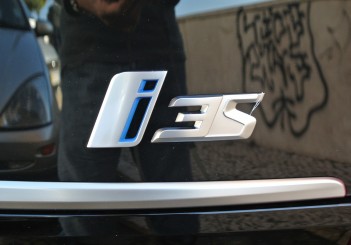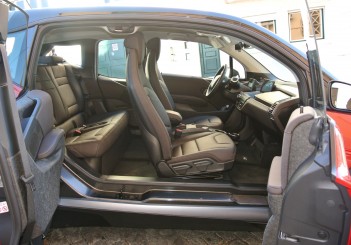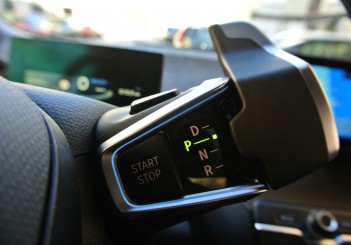Although many new buildings have been constructed to replace aging ones, they still bear some retro-styling which adds to the quaint charm of this Portuguese capital.
Another interesting area less explored by commercial tourism is the old city portion, hidden in a maze of narrow cobblestone streets.

The path along the old city is lined with nondescript residences with balconies and clotheslines, and alfresco sidewalk cafes which we chance upon by following satellite-navigation instructions.
By default, most automobile sat-nav system are set to use the shortest route, that includes alleys and backroads, unless waypoints have been keyed in much earlier.

With walls just centimetres away on both sides of the i3s media test unit, there was not even enough space for a motorcycle to pass by.
We were beginning to suspect that the path was better suited for pedestrians and scooters as there were no other cars in sight except ours.

Sweat began to break out on our brows when we arrived at right angle turn which seemed impossible for us to pass without denting the doors or scraping the bumpers of the i3s against the sturdy walls.
But thanks to the i3s’ tight turning capability and compact body, we managed to manoeuvre slowly through this tight spot and onwards to our downtown destination intact.
Since the introduction of the i3 in 2013, BMW has set the template for its vision of a proper green city car that is unconventional, efficient and lightweight with the use of carbon fibre passenger cell and aluminium chassis.

Introduced alongside is the sportier i3s variant that gets additional goodies like a more powerful electric motor at 185hp (vs 170hp in i3), one size-up 20-inch wheels, tyres are 20mm wider than those on i3, a 40mm wider rear track, adaptive sport steering, new dynamic traction control and a 10mm lowered sports suspension.
Peak torque and top speed are also higher in the i3s at 270Nm and 160kph respectively compared with 250Nm and 150kph from the i3.

BMW says the driving range, however, remains the same with both variants around 200km on everyday use in urban areas.
Charging times for up to 80% capacity from empty can range from 39 minutes using a 50kW DC outlet to 11 hours with a domestic socket. Also available are BMW i Wallbox chargers with varying output.

The i3s is designed to be compact and the use of light-colour materials and large windows invoked a sense of spaciousness.
Also, the reverse-hinged swing-out design of the rear doors and the absence of the B-pillars made it easy for the passengers in the back to enter and exit the i3s.
While the thinner back rests of the front seats free up more legroom for rear passengers, they continue to offer an acceptable level of comfort and back support for long distance driving.

Boot space has a capacity of 260 litres which can be increased to 1,100 litres with rear seats folded down.
Starting the i3s up is done by pressing the start/stop button on the drive controller stub and the car drives off with a barely noticeable electric motor hum.
Step on the accelerator and power kicks in instantly and smoothly, giving a turbo charged-like take-off minus the exhaust roar.
As the i3s does not come with a multi-speed transmission, the acceleration does not get interrupted by gear upshifts like in conventional cars.

As the i3s was running on large tyres and using a rear wheel-drive system, its steering action as well as feel and feedback were as good as any BMW cars I have ever tested.
We initially thought that the i3s’ high architecture design might affect its high-speed handling but were proven wrong.
The 230kg battery pack placed under the floor of the i3s had given the electric car a lower centre of gravity and hence the planted feel, confident handling and cornering stability.

Upon our arrival at Estoril Circuit, we got to test the new dynamic traction control system of the i3s, which allowed minor controlled-drifts on a wet slalom course.
BMW officials say the new system would increase the fun-to-drive factor of the i3s and debunk the notion that eco-friendly cars are boring.

With the current national automotive policy favouring locally-assembled electrified vehicles, it’s unlikely that the completely-built up i3s will be arriving here any time soon.
SPECIFICATIONS - BMW i3s

Maximum power: 135kW (184hp) at 7,000rpm
Maximum torque: 270Nm from 0 to 4,500rpm
Transmission: Automatic, single-speed with fixed ratio

Battery voltage: 353V
Battery capacity: 94Ah
Battery output (gross/net) kWh: 33.2/27.2

Acceleration (0–100kph): 6.9 seconds
Top speed: 160kph
Charging times (for 80% charge):
39 mins on 50kW DC;
11hrs from domestic socket (10A/240V),
7.30hrs from BMW i Wallbox (3.7kW/16A),
3.45hrs from BMW i Wallbox (7.4kW/32A, single-phase),
2.45hrs from BMW i Wallbox (11kW/16A, three-phase)
Range: up to 200km on everyday usage in urban areas
Price in Germany: Starts from 41,000 euros (RM199,000)








































